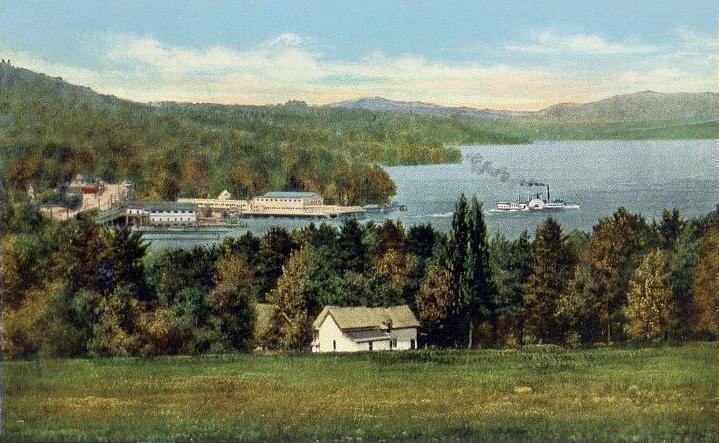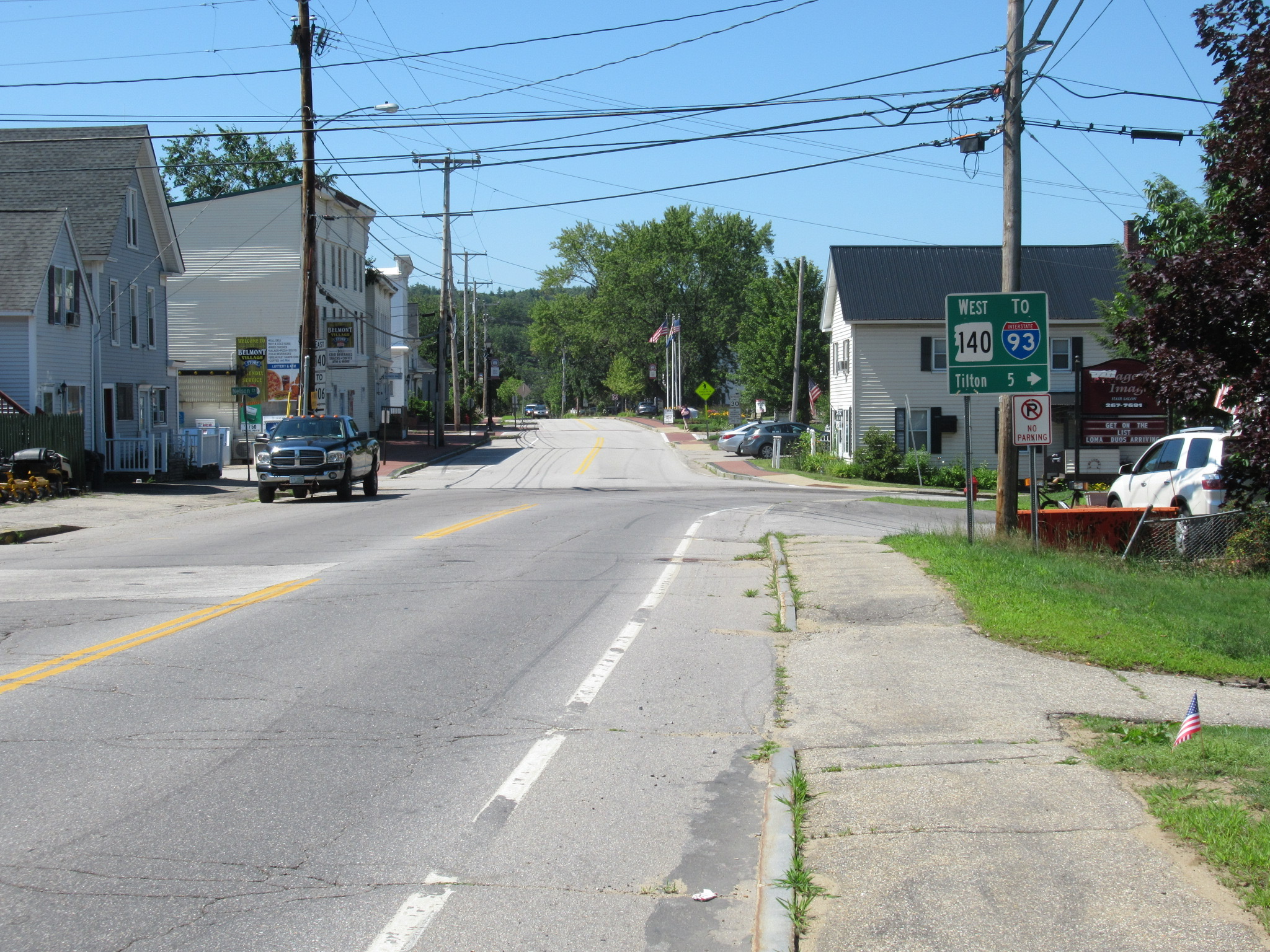|
Alton, New Hampshire
Alton is a town in Belknap County, New Hampshire, United States. The population was 5,894 at the 2020 census, up from 5,250 at the 2010 census. It is home to Alton Bay State Forest and Mount Major State Forest. The primary settlement in town, where 499 people resided at the 2020 census, is defined by the U.S. Census Bureau as the Alton census-designated place (CDP) and is centered on the intersection of New Hampshire Route 11 and New Hampshire Route 140. The town also includes the village of Alton Bay, a long-time resort located beside Lake Winnipesaukee. History Originally called "New Durham Gore" because of rocky upland areas, or "gores", the town was settled in 1770, mainly by farmers because the highland areas provided less frost. Merchants then filled the lowlands. Early Alton history recounts stories of the merchants trying to convince the farmers to incorporate. They would succeed on 15 January 1796, when the community was named after Alton, a small market town in Hamps ... [...More Info...] [...Related Items...] OR: [Wikipedia] [Google] [Baidu] |
Belknap County, New Hampshire
Belknap County () is a county in the U.S. state of New Hampshire. As of the 2020 census, the population was 63,705. The county seat is Laconia. It is located in New Hampshire's Lakes Region, slightly southeast of the state's geographic center. Belknap County comprises the Laconia, NH Micropolitan Statistical Area, which in turn constitutes a portion of the Boston-Worcester-Providence, MA- RI-NH- CT Combined Statistical Area. The southwestern half of Lake Winnipesaukee lies in Belknap County, while several other major lakes such as Squam Lake and Lake Winnisquam lie partially or wholly within the county. The Belknap Mountains lie along the shore of Winnipesaukee east of Laconia and feature Mount Major, known for its numerous hiking trails and Gunstock Mountain, home of a popular ski resort. Bank of New Hampshire Pavilion is a concert venue in Gilford which features major national touring music acts, while the Laconia Motorcycle Week attracts hundreds of thousands of visit ... [...More Info...] [...Related Items...] OR: [Wikipedia] [Google] [Baidu] |
2010 United States Census
The United States census of 2010 was the twenty-third United States national census. National Census Day, the reference day used for the census, was April 1, 2010. The census was taken via mail-in citizen self-reporting, with enumerators serving to spot-check randomly selected neighborhoods and communities. As part of a drive to increase the count's accuracy, 635,000 temporary enumerators were hired. The population of the United States was counted as 308,745,538, a 9.7% increase from the 2000 census. This was the first census in which all states recorded a population of over half a million people as well as the first in which all 100 largest cities recorded populations of over 200,000. Introduction As required by the United States Constitution, the U.S. census has been conducted every 10 years since 1790. The 2000 U.S. census was the previous census completed. Participation in the U.S. census is required by law of persons living in the United States in Title 13 of the United ... [...More Info...] [...Related Items...] OR: [Wikipedia] [Google] [Baidu] |
Corkscrew (tool)
A corkscrew is a tool for drawing corks from wine bottles and other household bottles that may be sealed with corks. In its traditional form, a corkscrew simply consists of a pointed metallic helix (often called the "worm") attached to a handle, which the user screws into the cork and pulls to extract it. Corkscrews are necessary because corks themselves, being small and smooth, are difficult to grip and remove, particularly when inserted fully into an inflexible glass bottle. More recent styles of corkscrew incorporate various systems of levers that further increase the amount of force that can be applied outwards upon the cork, making easier the extraction of difficult corks. History Its design may have derived from the gun worm which was a device used by men to remove unspent charges from a musket's barrel in a similar fashion, from at least the early 1630s.winepros.com.au. The corkscrew is possibly an English invention, due to the tradition of beer and cider, and ''Tre ... [...More Info...] [...Related Items...] OR: [Wikipedia] [Google] [Baidu] |
Shoemaking
Shoemaking is the process of making footwear. Originally, shoes were made one at a time by hand, often by groups of shoemakers, or cobblers (also known as '' cordwainers''). In the 18th century, dozens or even hundreds of masters, journeymen and apprentices (both men and women) would work together in a shop, dividing up the work into individual tasks. A customer could come into a shop, be individually measured, and return to pick up their new shoes in as little as a day. Everyone needed shoes, and the median price for a pair was about one day’s wages for an average journeyman. The shoemaking trade flourished in the eighteenth and early nineteenth centuries but began to be affected by industrialization in the later nineteenth century. Traditional handicraft shoemaking has now been largely superseded in volume of shoes produced by industrial mass production of footwear, but not necessarily in quality, attention to detail, or craftsmanship. Today, most shoes are made on a volum ... [...More Info...] [...Related Items...] OR: [Wikipedia] [Google] [Baidu] |
Sawmill
A sawmill (saw mill, saw-mill) or lumber mill is a facility where logs are cut into lumber. Modern sawmills use a motorized saw to cut logs lengthwise to make long pieces, and crosswise to length depending on standard or custom sizes (dimensional lumber). The "portable" sawmill is of simple operation. The log lies flat on a steel bed, and the motorized saw cuts the log horizontally along the length of the bed, by the operator manually pushing the saw. The most basic kind of sawmill consists of a chainsaw and a customized jig ("Alaskan sawmill"), with similar horizontal operation. Before the invention of the sawmill, boards were made in various manual ways, either rived (split) and planed, hewn, or more often hand sawn by two men with a whipsaw, one above and another in a saw pit below. The earliest known mechanical mill is the Hierapolis sawmill, a Roman water-powered stone mill at Hierapolis, Asia Minor dating back to the 3rd century AD. Other water-powered mills followe ... [...More Info...] [...Related Items...] OR: [Wikipedia] [Google] [Baidu] |
Gristmill
A gristmill (also: grist mill, corn mill, flour mill, feed mill or feedmill) grinds cereal grain into flour and Wheat middlings, middlings. The term can refer to either the Mill (grinding), grinding mechanism or the building that holds it. Grist is grain that has been separated from its chaff in preparation for grinding. History Early history The Greek geographer Strabo reports in his ''Geography'' a water-powered grain-mill to have existed near the palace of king Mithradates VI Eupator at Cabira, Asia Minor, before 71 BC. The early mills had horizontal paddle wheels, an arrangement which later became known as the "Water wheel#Vertical axis, Norse wheel", as many were found in Scandinavia. The paddle wheel was attached to a shaft which was, in turn, attached to the centre of the millstone called the "runner stone". The turning force produced by the water on the paddles was transferred directly to the runner stone, causing it to grind against a stationary "Mill machinery#Wat ... [...More Info...] [...Related Items...] OR: [Wikipedia] [Google] [Baidu] |
Boston & Maine Railroad
The Boston and Maine Railroad was a U.S. Class I railroad in northern New England. Originally chartered in 1835, it became part of what was the Pan Am Railways network in 1983 (most of which was purchased by CSX in 2022). At the end of 1970, B&M operated on of track, not including Springfield Terminal. That year it reported 2,744 million ton-miles of revenue freight and 92 million passenger-miles. History The Andover and Wilmington Railroad was incorporated March 15, 1833, to build a branch from the Boston and Lowell Railroad at Wilmington, Massachusetts, north to Andover, Massachusetts. The line opened to Andover on August 8, 1836. The name was changed to the Andover and Haverhill Railroad on April 18, 1837, reflecting plans to build further to Haverhill, Massachusetts (opened later that year), and yet further to Portland, Maine, with renaming to the Boston and Portland Railroad on April 3, 1839, opening to the New Hampshire state line in 1840. The Boston and Maine Railroad ... [...More Info...] [...Related Items...] OR: [Wikipedia] [Google] [Baidu] |
Hampshire
Hampshire (, ; abbreviated to Hants) is a ceremonial county, ceremonial and non-metropolitan county, non-metropolitan counties of England, county in western South East England on the coast of the English Channel. Home to two major English cities on its south coast, Southampton and Portsmouth, Hampshire is the 9th-most populous county in England. The county town of Hampshire is Winchester, located in the north of the county. The county is bordered by Dorset to the south-west, Wiltshire to the north-west, Berkshire to the north, Surrey to the north-east, and West Sussex to the south east. The county is geographically diverse, with upland rising to and mostly south-flowing rivers. There are areas of downland and marsh, and two national parks: the New Forest National Park, New Forest and part of the South Downs National Park, South Downs, which together cover 45 per cent of Hampshire. Settled about 14,000 years ago, Hampshire's recorded history dates to Roman Britain, when its chi ... [...More Info...] [...Related Items...] OR: [Wikipedia] [Google] [Baidu] |
Alton, Hampshire
Alton ( ) is a market town and civil parish in the East Hampshire district of Hampshire, England, near the source of the River Wey. It had a population of 17,816 at the 2011 census. Alton was recorded in the Domesday Survey of 1086 as ''Aoltone''. During the Saxon period Alton was known as ''Aweltun''. The Battle of Alton occurred in the town during the English Civil War. It also has connections with Sweet Fanny Adams and Jane Austen. History Early history The Alton Hoard of Iron Age coins and jewellery found in the vicinity of the town in 1996 is now in the British Museum. There is evidence of a Roman posting station at Neatham near Alton, probably called Vindomis, and a ford across the River Wey on the line of a Roman road that ran from Chichester to Silchester. An Anglo-Saxon settlement was established in the area and a 7th-century cemetery was discovered during building excavations. It contained grave goods including the ''Alton Buckle'' which is on display in the Curtis ... [...More Info...] [...Related Items...] OR: [Wikipedia] [Google] [Baidu] |
Frost
Frost is a thin layer of ice on a solid surface, which forms from water vapor in an above-freezing atmosphere coming in contact with a solid surface whose temperature is below freezing, and resulting in a phase change from water vapor (a gas) to ice (a solid) as the water vapor reaches the freezing point. In temperate climates, it most commonly appears on surfaces near the ground as fragile white crystals; in cold climates, it occurs in a greater variety of forms. The propagation of crystal formation occurs by the process of nucleation. The ice crystals of frost form as the result of fractal process development. The depth of frost crystals varies depending on the amount of time they have been accumulating, and the concentration of the water vapor (humidity). Frost crystals may be invisible (black), clear (translucent), or white; if a mass of frost crystals scatters light in all directions, the coating of frost appears white. Types of frost include crystalline frost (hoar fro ... [...More Info...] [...Related Items...] OR: [Wikipedia] [Google] [Baidu] |
Lake Winnipesaukee
Lake Winnipesaukee () is the largest lake in the U.S. state of New Hampshire, located in the Lakes Region at the foothills of the White Mountains. It is approximately long (northwest-southeast) and from wide (northeast-southwest), covering — when Paugus Bay is included—with a maximum depth of . The center area of the lake is called The Broads. The lake contains at least 264 islands, half of which are less than in size, and is indented by several peninsulas, yielding a total shoreline of approximately . The driving distance around the lake is . It is above sea level. Winnipesaukee is the third-largest lake in New England after Lake Champlain and Moosehead Lake. Outflow is regulated by the Lakeport Dam in Lakeport, New Hampshire, on the Winnipesaukee River. History The Abenaki name ''Winnipesaukee'' (often spelled Winnipiseogee in earlier centuries) means either "smile of the Great Spirit" or "beautiful water in a high place". At the outlet of the lake, th ... [...More Info...] [...Related Items...] OR: [Wikipedia] [Google] [Baidu] |
New Hampshire Route 140
New Hampshire Route 140 is a east–west state highway in central New Hampshire, running from Tilton to Alton. The western terminus of NH 140 is in Tilton at an intersection with U.S. Route 3, New Hampshire Route 11 and New Hampshire Route 132, located at exit 20 on Interstate 93. The eastern terminus is in Alton at NH 11 and New Hampshire Route 28A (Main Street). In Alton, the road is named the Frank C. Gilman Highway. NH 140 (along with I-93) is commonly used as an alternative for motorists during the busiest NASCAR events at New Hampshire Motor Speedway in Loudon. The main highway to the speedway, New Hampshire Route 106, is converted to one-way traffic to accommodate the increased amount of traffic. Major intersections References External links New Hampshire State Route 140on Flickr 140 140 may refer to: * 140 (number), an integer * AD 140, a year of the Julian calendar * 140 BC, a year of the pre-Julian Roman calendar * ''140'' (video game), a 2013 platf ... [...More Info...] [...Related Items...] OR: [Wikipedia] [Google] [Baidu] |








